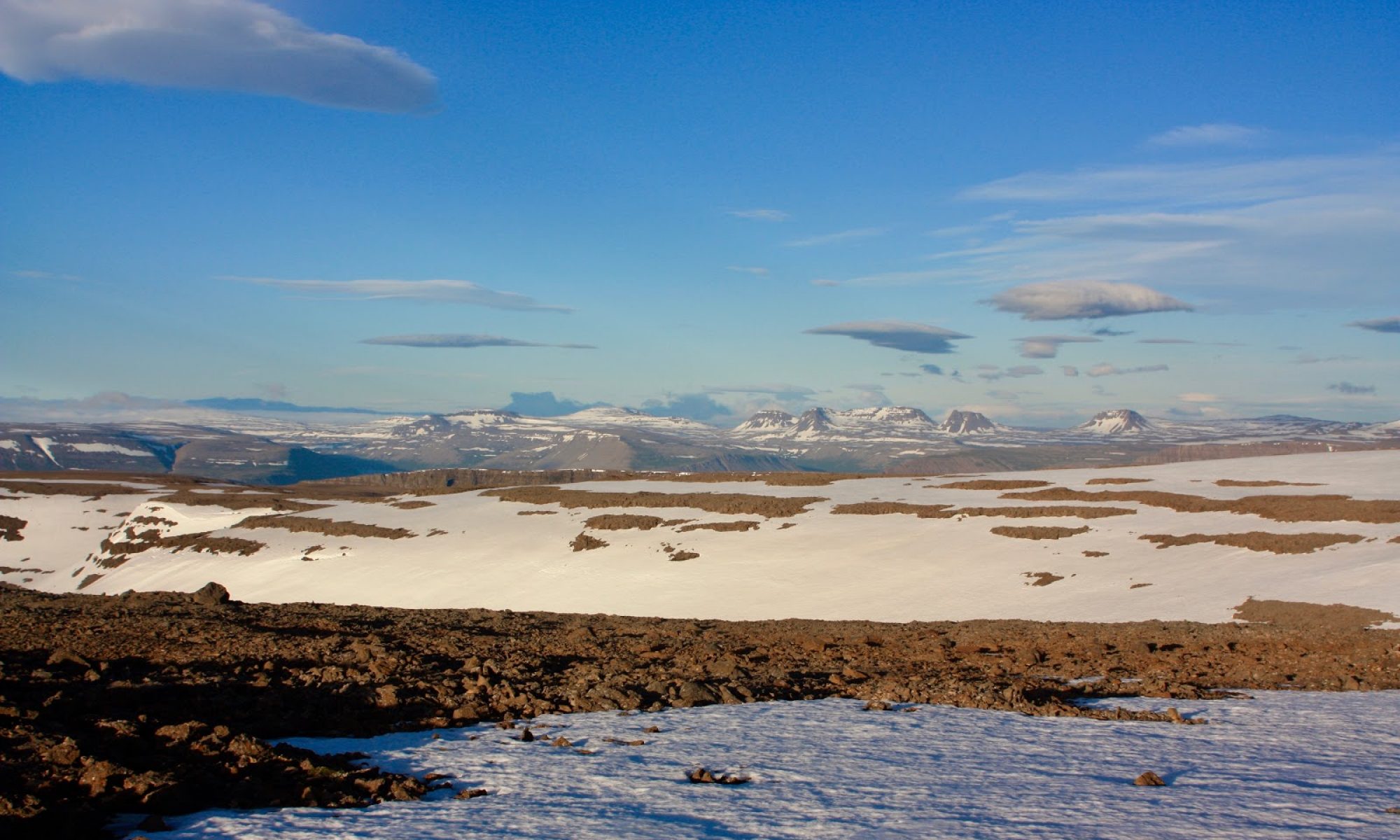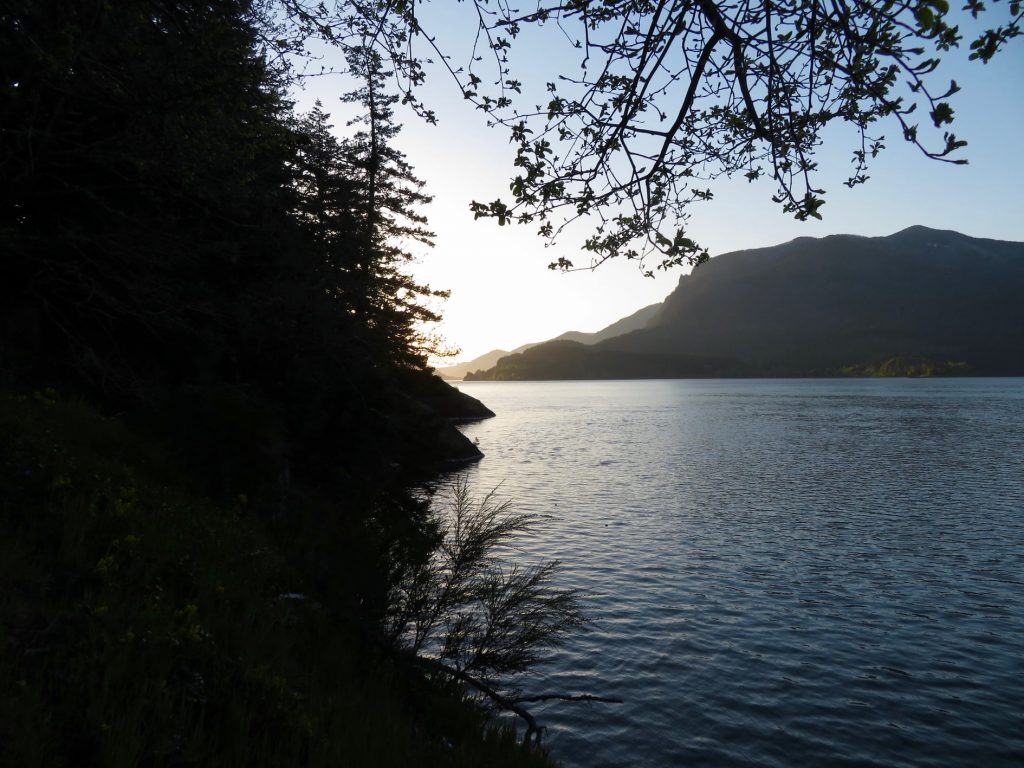
The day begins before sunrise, in the Skamania cemetery, on the banks of the Columbia. It is the still hour, the hour of dew and cold blue light. This is when the river speaks most clearly to me.
For a long time, I enjoy the silence and watch the inscrutable surface of the water. Gradually, a song enters my mind. A song that moves the way this deep and ancient river moves at dawn. O Magnum Mysterium.
Morten Lauridsen, the composer of this achingly beautiful piece, is a Northwesterner. He composes his choral works on the shore of a roadless island in the San Juans, perched in a bare-bones cabin above a channel where powerful tides ebb and flow.
I think it comes through in his music, which moves as water does, currents swelling under the surface. The Latin text is about the birth of Christ, but I feel the song as a celebration of incarnation, however one may understand and experience it.
Spirit embodied in flesh, moving through us and beyond us. In the still hour on the banks of the Columbia, I feel that the spirit of all life moves through water, which, after all, infuses every cell of every creature.
Water can be understood first of all as a physical substance, a molecule made up of two atoms of hydrogen and one of oxygen. As such, it is subject to the laws of physics and chemistry, but it is also—in just about every culture on earth, that I’m aware of—held to be a sacred and spirit-sustaining substance.
Water, along with vulcanism, is a primary shaper of the earth. It is a force that both gives life and takes it away. Its movement through both the landscape and through the living cells of all creatures is, simultaneously, the most powerful and the most gentle of all terrestrial forces.
It is a recurring theme in my writing these past few years, this dual nature of water. The undeniable force of it; the sustaining grace of it. During my journey into the gorge, I am intrigued by the story told in stones, seduced by the blossoming orchards, entranced by the diversity and ingenuity of flowers. But always I return to the river.

It may seem that a river is a mutable thing, a temporary feature of the landscape in comparison to the solid ramparts of stone or the towering cones of the Cascade Range. But in fact the river is ancient. It has been here longer than the mountains have been.
When travelers in the Columbia River Gorge see the icy white volcanoes on both sides of the river, and see the many layers of basalt that comprise the walls of the gorge, a common assumption they make is that the volcanoes are responsible for the basalt. They are not. The lava is much older than the mountains, and the river, in turn, is older than the lava.
The basalt layers were laid down by ancient volcanoes in the vicinity of what is now Hell’s Canyon. Starting about 17 million years ago, a proliferation of parallel cracks in the earth opened up, and began to gush a phenomenal volume of lava. The eruptions occurred over the span of a couple million years, and in that time huge rafts of lava called “flood basalts” covered much of what is now Oregon, Idaho, and Washington.
The flood basalts are many-layered. The geologist Nick Zentner has compared them to layers of a German Chocolate cake, and it is a pretty apt metaphor. At the time the basalt was laid down, the land was relatively flat. This is why the layers are quite uniform in thickness, even as they tilt upward and rise through the deepest part of the gorge. And then—slowly on a human scale, but quickly on a geologic scale—the Cascades were thrust upward. The banks of the Columbia rose over 3000 feet in about 3 million years, and through it all, the elevation of the river stayed constant, holding its own. Think of how the blade of a table saw is stationary as you push a piece of wood into it.
The Cascades rose because one of the earth’s tectonic plates was colliding with another, and, in a process called subduction, diving beneath it. In essence, this crumples the surface of the earth. As the subducted plate is forced downward, it melts, creating a reservoir of magma that rises to the surface and finds expression in stratovolcanoes such as St. Helens, Rainier, Adams, and Hood.
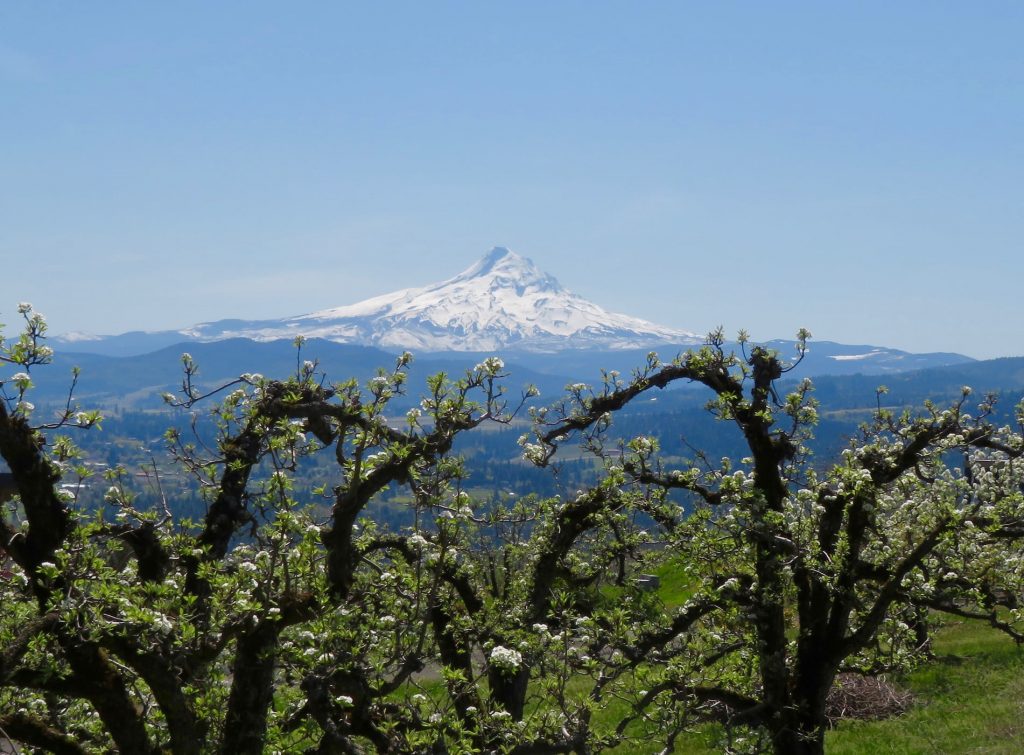
I say “such as” because a stratovolcano is a slag heap of rotten rock, and has a short life, as mountains go. Along the spine of the Cascades, these iconic white cones that seem so enduring are, in fact, a young feature. They come and go. There were other volcanoes before them, and there will be more after their demise. In a north-south line along the spine of the Cascades, above those places where magma gathers, they will sprout like ephemeral mushrooms along a weak seam in a rotting log.
Things are not as they seem. The mountains seem changeless and the river seems ever-changing. But the river—which is always fluid, which with each passing second is, as Heraclitus famously said, always a different river—is the constant.
On the wet western end of the gorge, the rock that comprises the walls of the gorge is somewhat obscured by dense foliage, but as you move eastward into the dry eastern end, the bones of the gorge are increasingly revealed.
Extravagant evergreen forest gives way to open groves of gnarled Garry Oak and grasses that are verdant in spring, but within a few months will be burnished bronze in late-afternoon summer sun. They will soften with gauzy seed-heads. The grass and oak groves alternate with smoky grayish-black basalt cliff bands and talus slopes. It gives the effect of terraced slopes.
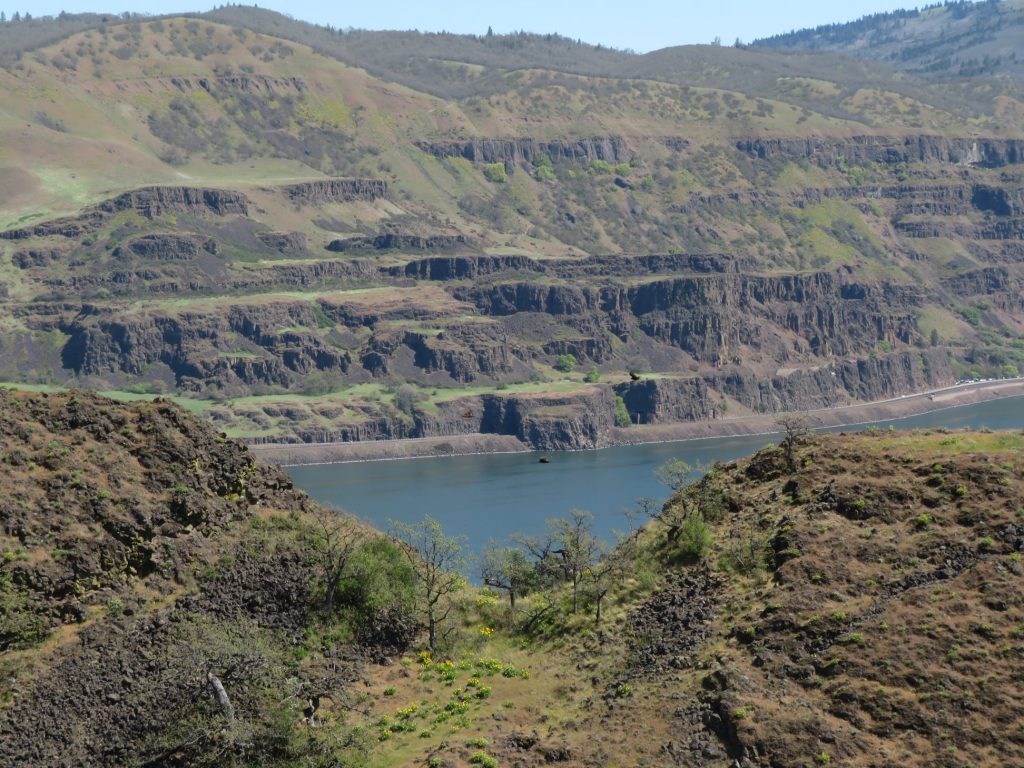
The benches that bask in the sun are freckled with wildflowers such as lupine, grass widow, and balsam root. In April, the eastern end of Columbia River Gorge is bathing in sunshine and coming alive. An astonishing diversity of blooms carpet the slopes. But the further east you go, the more the softness of vegetation fades until rock itself is the dominant feature.
And the rock has a story to tell. Reading rock strata is reading history, but the reading requires interpretation. For many years, geologists were puzzled by many features of the Columbia gorge. In time, it became clear that the land was shaped, decisively, by two different kinds of flood, both of them of a magnitude that is hard to imagine: Floods of lava, and floods of water. Both kinds of flood left a testimony, for those who were able to read it.
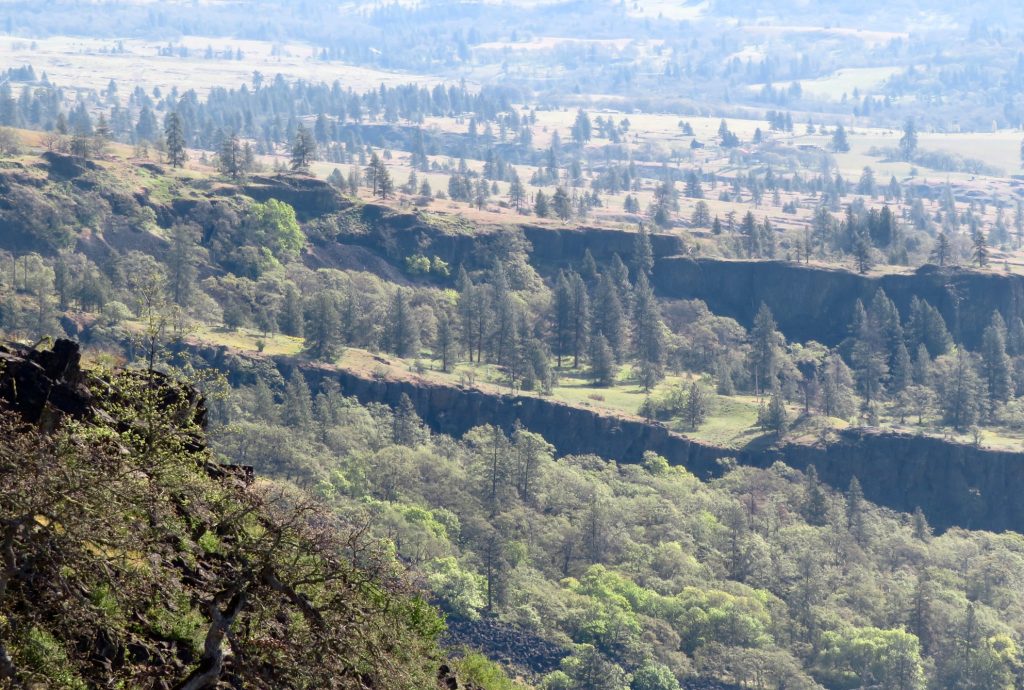
The man who read the walls of the gorge most carefully and interpreted them with greatest insight, a geologist by the name of J. Harlen Bretz, was ridiculed by other geologists for most of his career.
The reason for this scorn was his theory of a catastrophic flood large enough to fan out across most of Eastern Washington, powerful enough to strip the topsoil from hundreds of thousands of acres, capable of creating deep and wide gouges in the desert such as Grand Coulee, and voluminous enough to fill the entire Willamette valley with backed-up water. Bretz thought this flood explained many things that could not in any other way be adequately explained.
He was right, but for several decades it was considered an outlandish and fanciful story, and Bretz was accused of trying to sneak a “biblical flood” in through the back door of geology, a cartoonish catastrophe to explain natural features that surely must have a more prosaic genesis. But Bretz stuck to his guns, and his reading of the stone textbook eventually persuaded other geologists.
More and more evidence bore him out, and now every student of Northwest geology knows about how the Scablands were formed, and how glacial Lake Missoula—the size of modern-day Lake Ontario—drained in a hurry when an ice dam from a retreating ice sheet gave way and unleashed the great flood. Or, to be precise, failed and re-formed and failed again, releasing a series of great floods.
How big was the largest of these floods? Well, near the town of The Dalles, Oregon, on the eastern end of the gorge, the high-water mark is around 800 feet above the present level of the river. Downstream, where the gorge gets narrower, the high-water mark is between 900 and 1000 feet above the river.
On the west end of the gorge, not far from Portland, many travelers stop at the Vista House, an ornate little cupola perched high on a basalt cliff. This iconic viewpoint provides a magnificent view upriver. It is hard to imagine, while sitting on the stone wall at Vista House, hundreds of feet above the Columbia, floodwaters that reached 400 feet above the viewpoint.
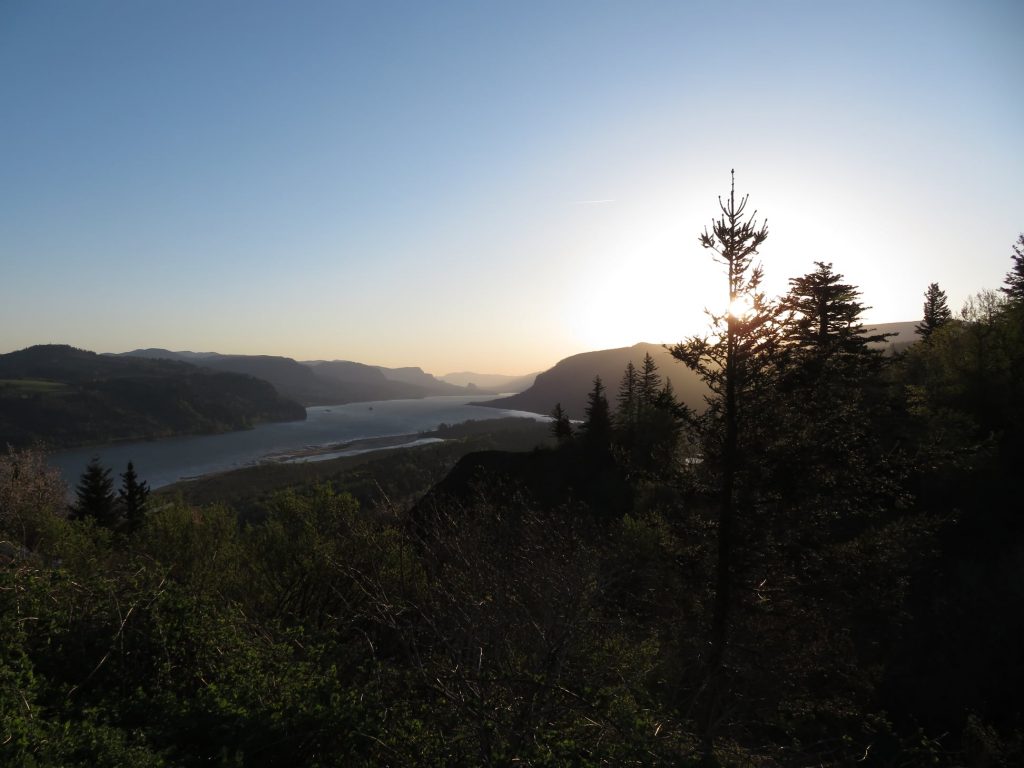
The inconceivably vast and powerful floods splayed widely across what is now Eastern Washington, eliminating the rolling hills that had been there, and gouging into the underlying basalt. The relentless water penetrated fractures in the basalt and pried chunks of it loose, creating broad flat-bottomed and sheer-walled canyons called coulees like the mile-wide Moses Coulee, and of course the famous Grand Coulee, site of the largest concrete American dam.
Drawn generally south-westward by gravity, the water gathered and pooled behind a natural geographical constriction at Wallula Gap. This temporary lake, designated Lake Lewis in honor of Meriwether Lewis, was near in size to Lake Missoula. Imagine the power of a body of water that size, funneled through a gap in a ridge. Downstream from here, the water entered the gorge where it both gathered speed and rose higher.
At various points where the gorge narrowed and choked the flow, water again backed up and slowed down, depositing sediment it had carried to that point, including mammoth boulders brought all the way from what is now Montana, embedded in icebergs that were left behind on benches, like bits of food left behind when a sink drains.
These boulders, which are different in composition from the black basalt cliffs of the gorge, are poetically known as erratics. They are not only in the gorge; they are all over Central Washington, where it is not uncommon to see a huge light-colored boulder—or a cluster of them, like a more random version of Stonehenge—in the middle of a wheat field. And they are scattered throughout the orchards and vineyards of Oregon’s Willamette Valley.
The word erratic is derived from the Latin for wanderer. It usually applies to a stone moved by a glacier, a stone that is out of place. In the gorge, these boulders are ice-rafted erratics, carried by floods. They can be found several hundred feet above the river, stranded in meadows. Like a baby swan among goslings, out of place.
Giant boulders from Montana. Forty, fifty, ninety tons. In a landscape of chocolate-dark basalt, they stand out: banded granite or metamorphosed shale, gleaming white in the sun. Rocky Mountain stones. I’m reminded of the Talking Heads song: And you may find yourself in another part of the world… And you may ask yourself, “Well… how did I get here?”
The water backed up for hundreds of miles into the Willamette River Valley, dropping the sediment that is responsible for one of the richest and most fertile farming areas in America. Oregon’s prank on Washington: Hundreds of thousands of acres of prime Washington topsoil, deposited for free in Oregon. Floating icebergs settled and melted, leaving behind the erratics trapped within them.
And then the water went away. It drained into the ocean and it percolated into the ground. It went back up into the sky to fall as snow again. It didn’t go away; it shape-shifted. It infuses everything. As I wind down the highway fifteen-thousand years later, the Talking Heads song is stuck in my head:
Letting the days go by, let the water hold me down… Letting the days go by, water flowing underground… Into the blue again, into the silent water… Under the rocks and stones, there is water underground.
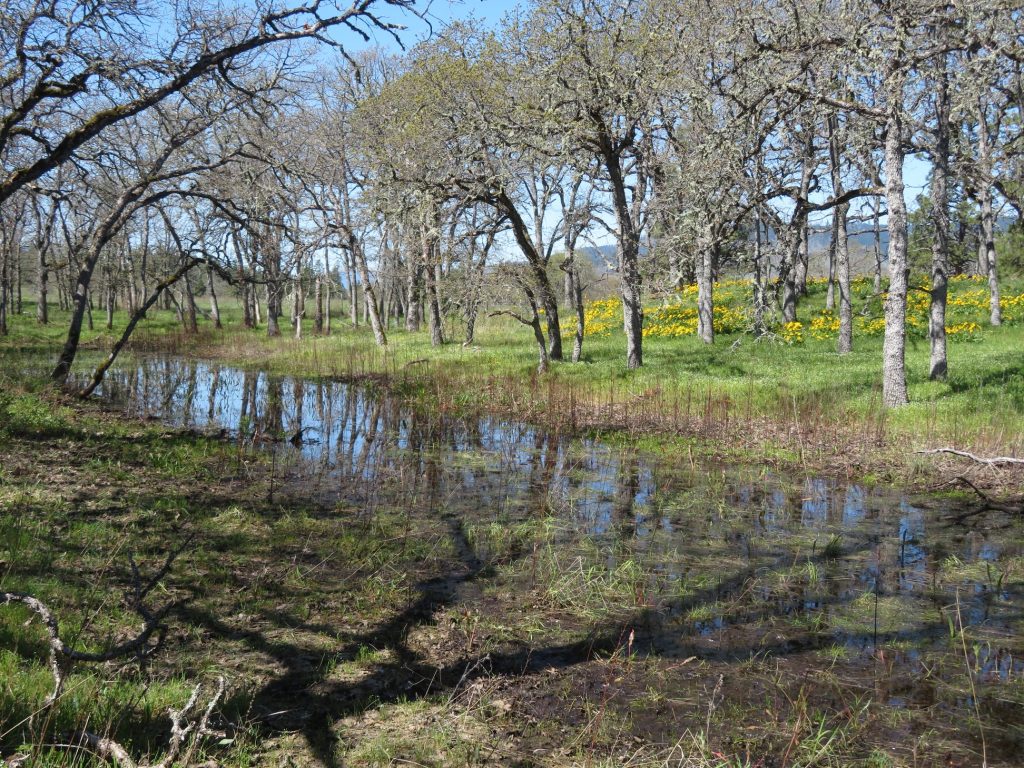
It may be the case that many travelers through the gorge are aware, either vaguely or with some degree of precision, of the gargantuan floods that ripped through the gorge between 11,000 and 15,000 years ago, near the end of the last ice age. The once-ridiculed theory of J. Harlan Bretz has now moved into the body of common knowledge. Just like the idea of plate tectonics and subduction zones, glacial Lake Missoula and the Ice-age floods that it spawned have crossed over from the rarified world of geology journals into the awareness of tourists who stop to read roadside markers along the Columbia River scenic highway.
However, people can still make faulty assumptions from accurate knowledge. And one of those assumptions held by many in the Northwest—along with the mistaken notion that the gorge’s basalt was laid down by Cascade volcanoes—is that the ice-age floods carved out the Columbia River Gorge.
Perhaps it’s easy to think that a lake the size of Lake Ontario, when it drains abruptly and creates a flood huge enough to strip the soil from half a state, can punch its way through anything, including a formidable mountain range.
But the ice-age floods from glacial Lake Missoula did not create the gorge. It was just one more chapter in the river’s long story. The gorge was already here, and the floods merely widened and further sculpted it. They picked at weaknesses in the basalt, stripping away the pickings. They widened the base of the valley floor, leaving behind the sheer walls on the Oregon side that make this place a Mecca for waterfall lovers. They stripped away most of a small volcano that was smack-dab in the way, leaving behind the resistant inner plug of lava that we now call Beacon Rock.
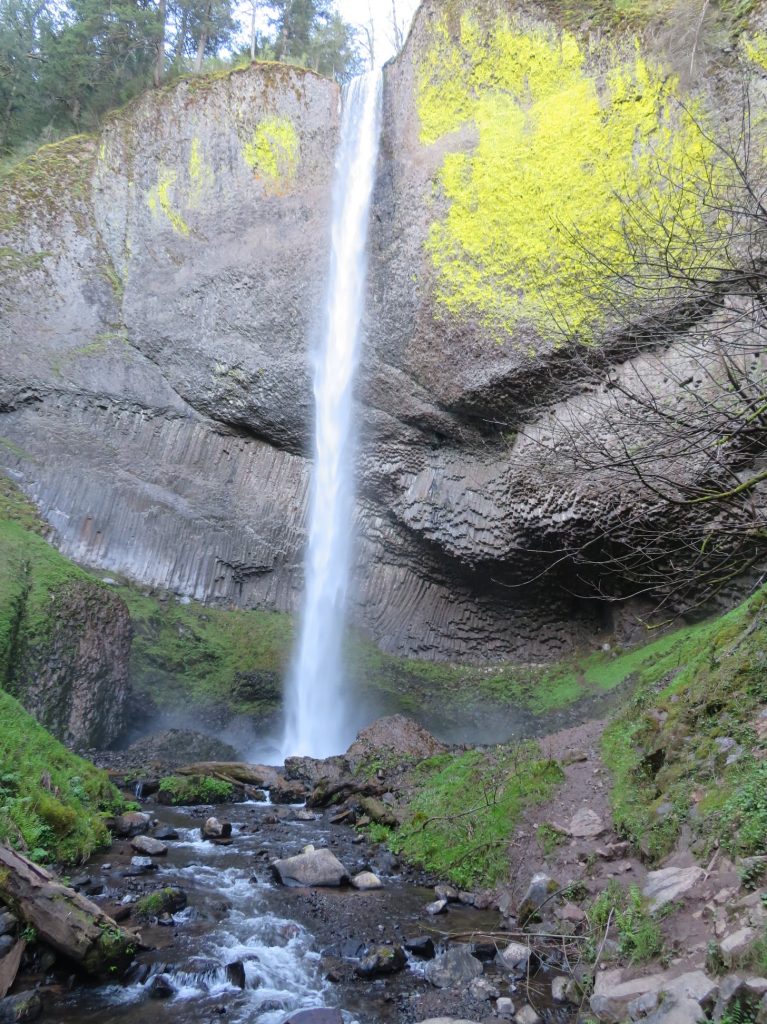
Throughout the long stretch of time, the river’s flow has been interrupted by natural dams made by glaciers and landslides. In modern times, both the Columbia and its main tributary, the Snake, are now impounded by a series of man-made concrete dams. These dams produce electricity, facilitate irrigation, and allow for large boat and barge travel all the way to Lewiston, Idaho. For much of its course, the river is now a sequence of lakes.
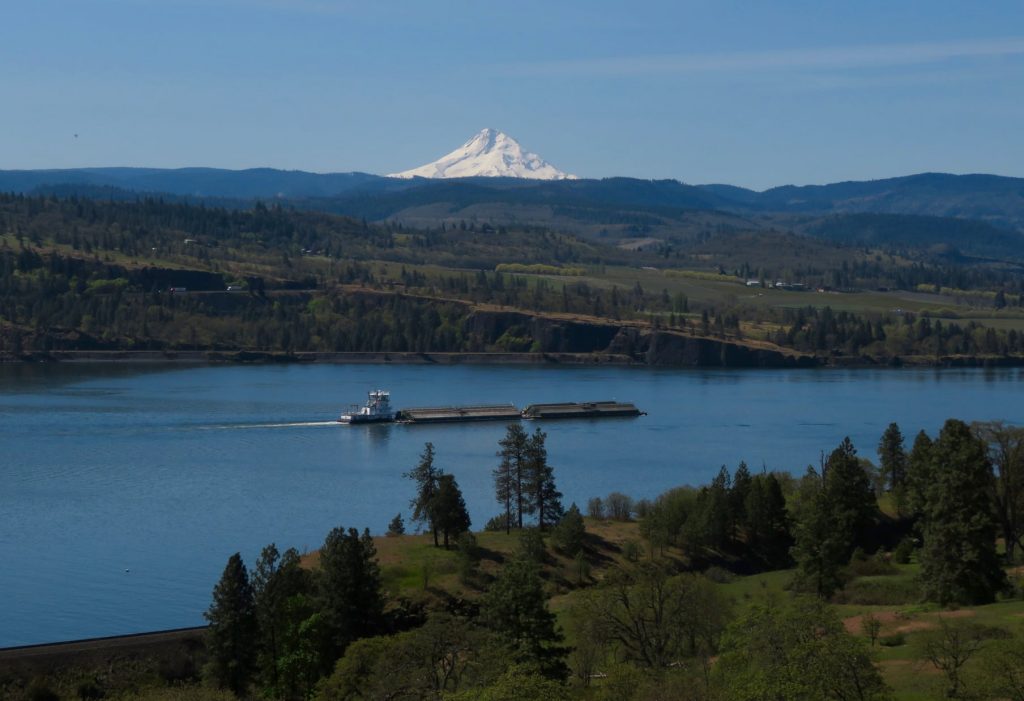
The dams also have damaged the natural ecosystem of a flowing river in numerous ways, the most obvious being the decline of salmon runs. Before the construction of these dams, the Columbia watershed was—hands down—the most productive salmon fishery on earth. It is hard, these days, to imagine the abundance that once was. Lewis and Clark’s journals give us an inkling.
We can manipulate water in any number of ways, we can put it in a billion plastic bottles, we can poison it, we can generate electricity from it, we can go to court or to war over who pretends to own it, we can even kill off the living creatures in water by altering its temperature or acidity, but the water itself is not subjugated.
Whatever we do in the short term—erect dams, build levees and seawalls, dredge channels, drain wetlands, divert rivers, deplete aquifers—water will have the last word in our conversation with it. This last word may not be to our liking. On the other hand, if we understand and cherish and respect it, it will continue to sustain us.
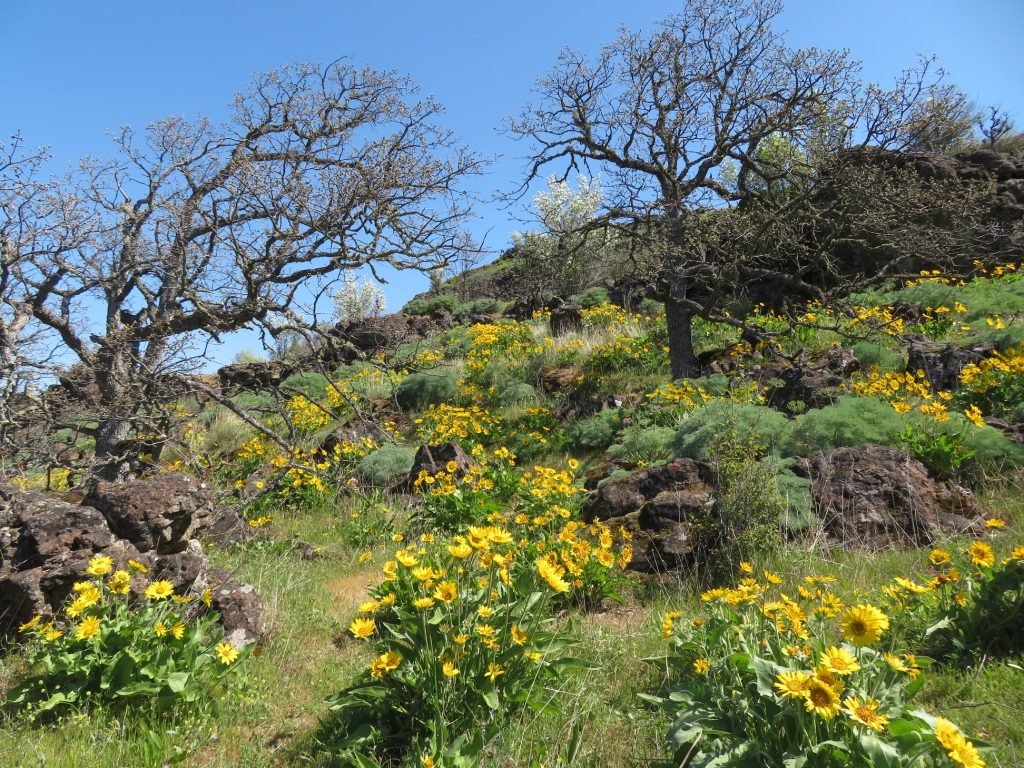
I have come to the gorge in the third week of April because it is the peak of wildflower season down here. The high country of the North Cascades, my usual stomping ground, is still buried in snow ranging from 100 to 140 inches deep. The lovely little alpine flowers I seek above timberline will not see the light of day until around the summer solstice.
But down here, April is the tender month. There is water underground. There is water in the air in the still hour before sunrise. Snowpack from the forests all around Mount Adams is starting to melt, and some of that that runoff fills the countless creeks that make their way to the Columbia, and some of it replenishes the groundwater.
When I imagine a flood towering 900 feet above the riverbank, a flood capable of carrying boulders from Montana, I like to follow that mental picture with this one: a dewdrop on the petal of a delicate lavender triteleia. One drop of dew. Of course, where there is one such drop, there are billions. Not possible to quantify. But each drop, in and of itself, contains the whole.
Coming across such a flower on a sun-baked south-facing bank later in the day, I might detect no moisture in the soil at all. I might test it with my finger and conclude that the soil is, as the saying goes, dry as a bone. But bones are not dry, and my finger is not discerning enough to detect what the flower’s roots can draw in. It doesn’t take much.
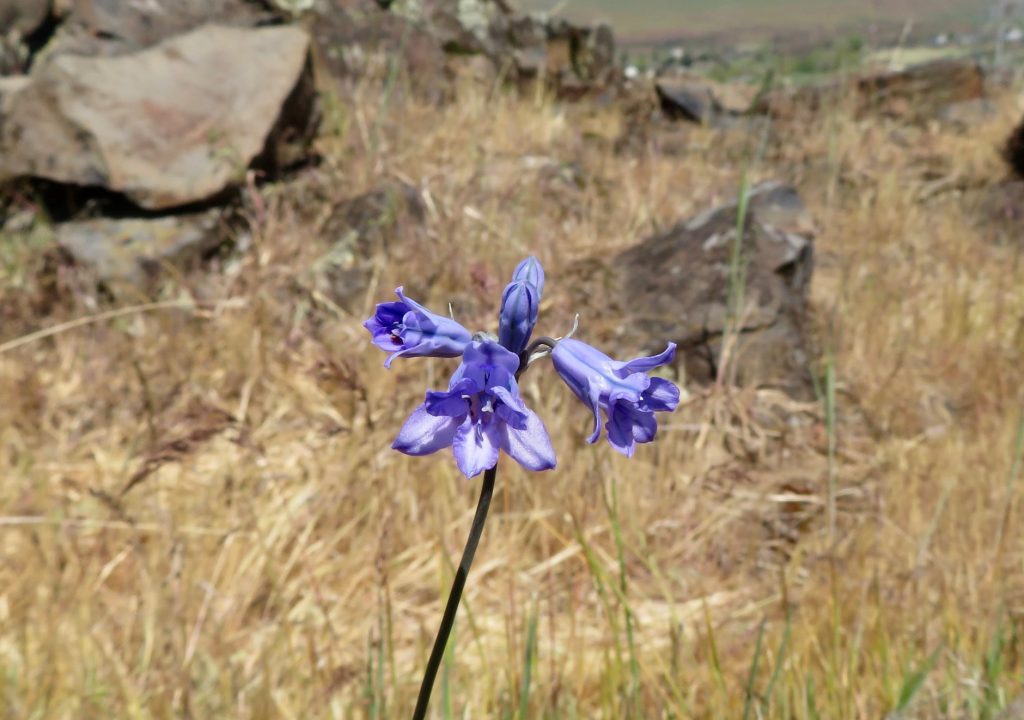
Does the soil moisture eventually become too scarce for the roots of of the triteleia to find it? Sure. But not before it blooms, is pollinated, and drops seed. The seed will wait; it is patient. When the time is right, it all happens quickly. It will not miss its chance.
One of my favorite places in the gorge is an area of blocky and broken basalt known as the Labyrinth. It is a kind of garden of stone. The architecture bears witness to the floods that stripped away weaker rock and left more resistant outcrops behind. The territory is perfect for many desert flowers that thrive in thin, rocky soil.
In hollows and along benches where the soil is a little better, there are intermittent groves of Garry Oak. When a blush of new grass is under the groves, and tender new leaves just budding out on the trees, it seems an idyllic place for some Bacchanalian display of carnality—but such behavior might lead to a good deal of suffering later, as Poison Oak is as present in this neighborhood as Garry Oak.
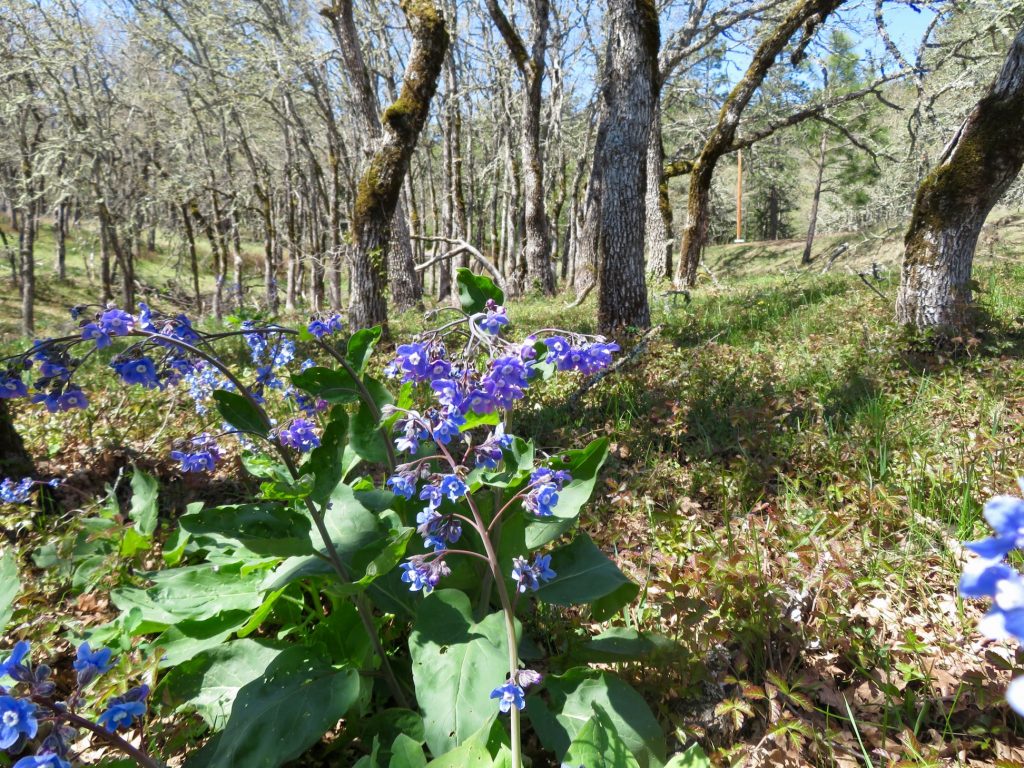
Above the labyrinth, raptors—both eagles and hawks—wheel constantly in broad circles, catching thermals. It is common for a stiff breeze from down the gorge to shave the grass. Patches of bright yellow balsam root nod in the wind.
A delightful seasonal creek threads its way through the corrugated landscape. It ripples, it ricochets, it slips around boulders and tumbles ass-over-teakettle into one small pool and then another. It alternates between peaceful and frenetic. In between ledges, it rests in serene pools where it catches the sun and splinters it into crescents.
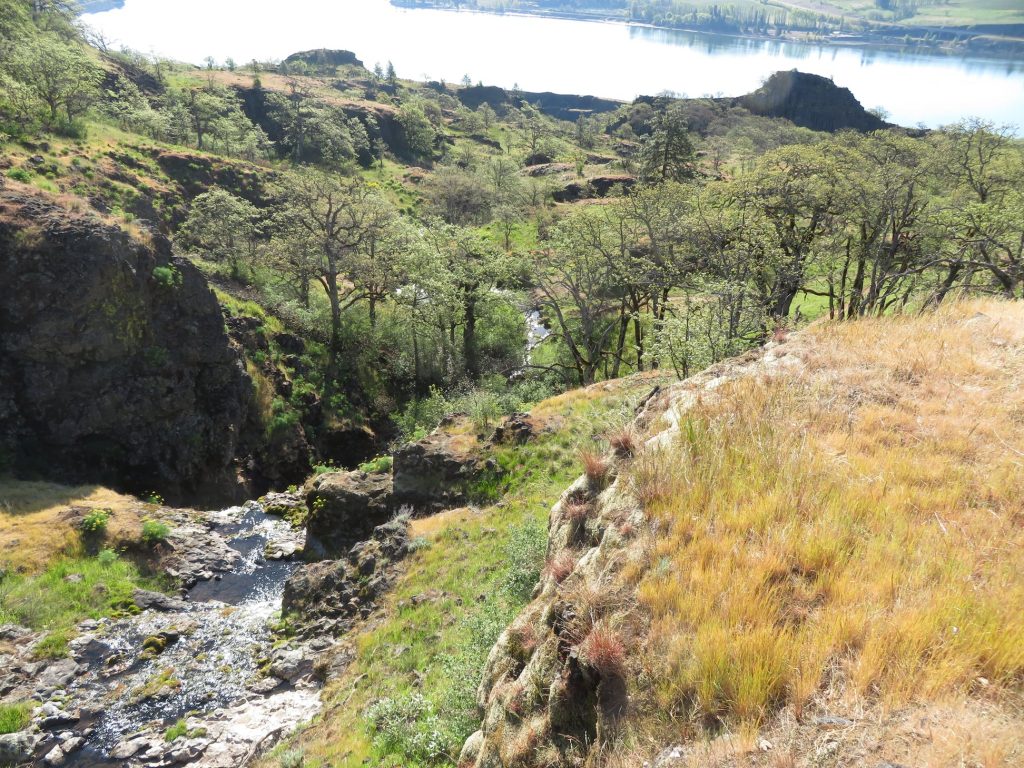
I will end this essay as I began it—with a song. It’s been a favorite song of mine since I first heard it as a twenty-year old full of dreams and longing. It is a song that captures the feeling I’m trying to communicate here: the spirit of moving water, specifically a creek on the slopes of the Columbia River Gorge as it finds its way down to the big river.
It’s a song that specifically celebrates water, and how we are sanctified by it. It is by the Native American jazz musician Jim Pepper, and is adapted from a ceremonial chant he learned from his uncle. I’ve often shared the song before, but this version is not Pepper’s; it’s a cover by the group Oregon. As with Morten Lauridsen, I think it is no coincidence that these are all northwest musicians. This land speaks to those who live here.
The sound of the oboe has sometimes been compared to the sound of a sick duck, but in the hands of Paul McCandless, and with his breath moving through it, it is sublime. And in this song, it moves like the creek as it finds its way through a labyrinth of basalt outcrops and ledges.
Just as the great river is drawn inexorably toward the ocean, this small creek—small in size but great in spirit—is drawn toward the river. Toward merging. Ever downward, but whirling on its way like a dervish. Singleminded in its love affair with gravity, but adapting to the contours of the land. Playful but with purpose.
The way this creek finds its way through this garden of stone could be a metaphor for a way to live life, to move through obstacles with ease and with joy. Toward confluence.
***
I don’t have a public comments option, but I welcome your responses. Feel free to leave a comment at markrozema62@gmail.com
